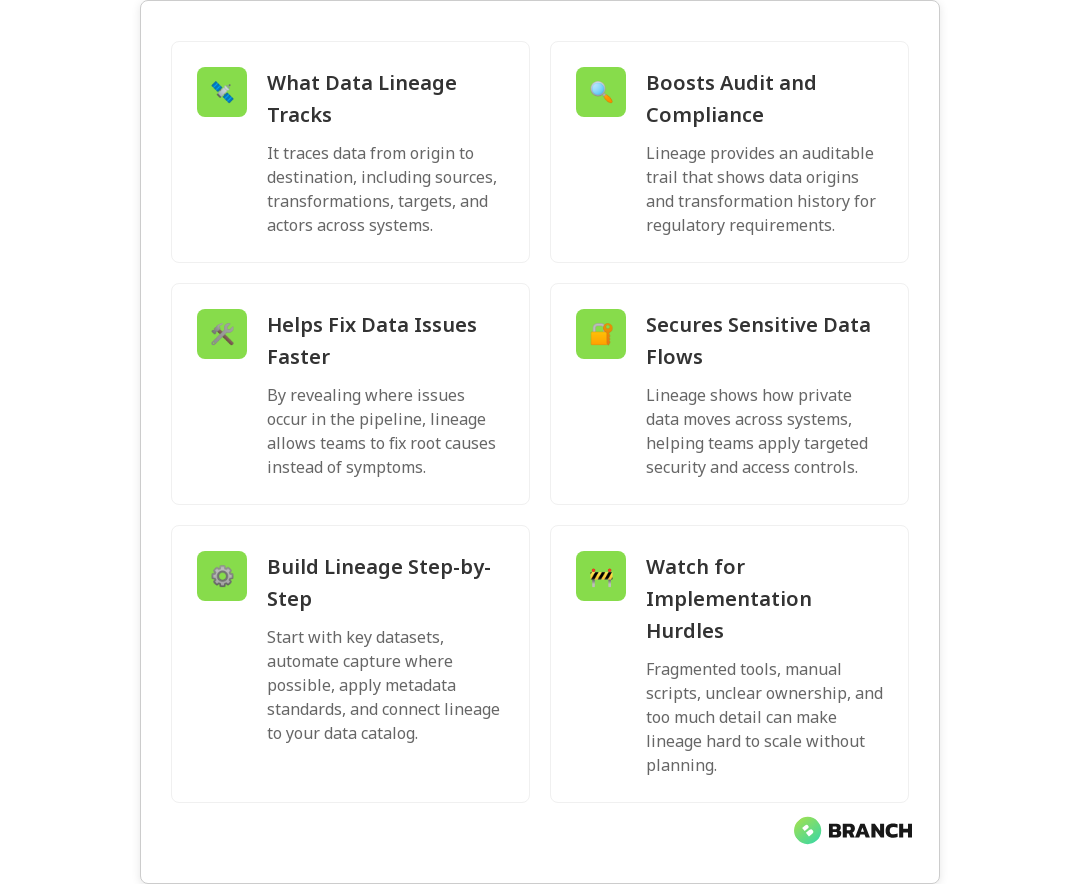Data lineage maps the life story of your data — where it came from, what happened to it, and where it ended up. In a world where business decisions, compliance audits, and machine learning models all rely on reliable data, lineage is the GPS and black box recorder rolled into one. This article explains what data lineage is, why it matters for governance, how to build it in practice, common challenges, and practical tips you can use today.
Why data lineage matters
Imagine an analyst finds a surprising drop in monthly revenue. Without lineage, tracing that number back to the source is like untangling a ball of holiday lights — frustrating and time-consuming. Data lineage provides the visibility to answer questions such as: Which source system contributed the value? Which transformations changed it? Which report uses that dataset? That traceability builds trust in analytics, speeds debugging, and helps meet regulatory requirements.
Governance programs depend on lineage because it ties policy to reality. Lineage shows where sensitive fields flow, who touches them, and where controls must be applied. For a concise overview of how lineage supports governance principles and compliance, see Dataversity’s guide to What Is Data Lineage?
Core concepts and types of lineage
At its simplest, data lineage documents:
- Sources — where the data originates (databases, APIs, files).
- Transformations — what happened to the data (joins, filters, aggregations, ML feature engineering).
- Targets — where the data lands (reports, dashboards, data warehouses, downstream systems).
- Actors and processes — jobs, pipelines, and users that moved or modified the data.
There are a few ways to categorize lineage:
- Physical lineage — concrete movement of files and tables through systems (what actually ran).
- Logical lineage — higher-level relationships between fields and datasets (business view of flow).
- Manual vs. automated lineage — manual documentation is helpful but brittle; automated lineage capture (via metadata, code parsing, or instrumentation) scales better.
For more on the different types and practical approaches, Informatica offers a helpful primer in their data lineage guide.
How lineage supports data governance
Lineage is the connective tissue that makes governance actionable. Here’s how it plays into common governance objectives:
- Compliance and audit readiness: Auditors want to know the origin of reported numbers and whether controls were applied. Lineage creates an auditable trail.
- Data quality and issue resolution: When quality problems appear, lineage helps isolate the responsible pipeline or transformation so teams can fix the root cause rather than patching symptoms.
- Security and privacy: Knowing how sensitive attributes flow across systems enables targeted masking, encryption, or access controls.
- Trust and collaboration: Business stakeholders are likelier to trust analytics when they can inspect how values were derived.
Research shows lineage increases transparency and trust while enabling teams to align handling practices with governance principles — see the university study “Tracing the Path” for an academic perspective on lineage’s governance impact: Tracing the Path: Data Lineage and Its Impact on Data Governance.
How to build data lineage — practical steps
Building lineage can feel intimidating, but a pragmatic approach reduces friction. Consider this phased strategy:
- Inventory and prioritize: Catalog critical datasets and reports. Focus on business-impact areas first (finance, compliance, customer metrics).
- Choose the right mix of capture methods: Use automated capture where possible (metadata extraction, ETL/ELT integration, code parsing). Supplement with manual entries for data flowing through non-instrumented systems.
- Adopt consistent metadata standards: Agree on naming, field definitions, and transformation documentation so lineage maps stay useful across teams.
- Integrate with a data catalog: Lineage paired with a catalog gives context — owners, SLA, sensitivity tags, and business glossaries — so governance actions are informed.
- Automate monitoring and alerts: Flag topology changes, unexpected schema drift, or failed pipelines so triage starts early.
- Embed into workflows: Make lineage part of release reviews, model validation, and incident postmortems so it’s a living asset, not a dusty diagram.
Platforms and vendor literature emphasize metadata-driven lineage and embedding lineage in catalogs to support governance and issue identification; Dataversity covers these strategies well in their overview What Is Data Lineage?.
Common challenges and how to overcome them
Lineage implementations can stumble for practical reasons. Here are frequent pain points and simple remedies:
- Fragmented toolchains: Multiple ETL tools, cloud providers, and legacy databases make lineage capture uneven. Remedy: prioritize connectors for high-value systems and use open lineage standards when possible.
- Manual processes and shadow pipelines: Business users running spreadsheets or ad hoc scripts create blind spots. Remedy: focus on education and lightweight policies that encourage registering ad hoc flows in the catalog.
- Ambiguous ownership: Without clear data owners, lineage maintenance lags. Remedy: assign dataset owners with responsibilities for lineage accuracy and periodic reviews.
- Noise and irrelevant detail: Too much low-level lineage can overwhelm users. Remedy: provide both high-level logical views for business users and detailed physical traces for engineers.
Automating lineage helps reduce human error and maintenance overhead. Secoda’s blog describes how automated lineage improves governance and trust in analytic outputs: What is the role of data lineage in data governance?.
Trends, tools, and where to invest
Lineage tooling has matured quickly. Look for solutions that:
- Support automated capture across ETL/ELT, streaming, and BI tools.
- Implement open lineage standards for portability and integration.
- Include both physical and logical lineage views for different user personas.
- Integrate with catalogs, access control, and data quality tooling for end-to-end governance.
Vendors and consultancies consistently highlight how lineage enables audit readiness, change management, and operational efficiency — for more on the specific governance benefits, Alation’s piece on lineage benefits is practical and business-minded: Understanding Data Lineage: Benefits and Integration.

FAQ
What is the meaning of data lineage?
Data lineage documents and visualizes the lifecycle of data: its sources, transformations, systems, and destinations, creating a traceable history.
Why is data lineage important?
Lineage builds accountability, supports compliance, improves data quality, and increases trust in analytics by making every transformation traceable.
What are the different types of data lineage?
Types include physical lineage (actual flows), logical lineage (conceptual relationships), and manual vs. automated lineage capture.
How to build a data lineage?
Start by cataloging critical datasets, use automated capture, define consistent metadata standards, integrate with a catalog, and automate monitoring.
What is the difference between data lineage and data provenance?
Provenance focuses on data origin and ownership (authenticity), while lineage maps the full journey including transformations and flows across systems.
Final thoughts
Data lineage isn’t a nice-to-have ornament for your data warehouse — it’s a practical necessity for trustworthy analytics, governance, and efficient operations. Start small, automate what you can, and make lineage accessible to both engineers and business users. With lineage in place, audits become less terrifying, debugging becomes quicker, and your organization gains a clearer view of the data that powers decisions. If you want help building lineage-friendly pipelines and metadata practices, connecting those engineering choices to governance is what we do best.




